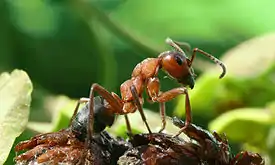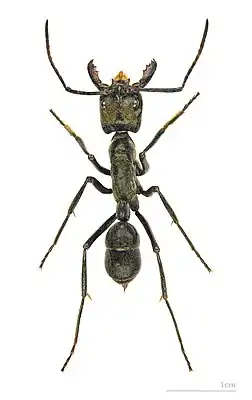Формицины
Формицины (лат. Formicinae) — подсемейство муравьёв (Formicidae), включающее эволюционно наиболее продвинутые виды. Около 3000 видов (51 род) в мире, в Палеарктике более 382 вида (23 рода), в России встречается 98 видов (12 родов)[1][2][3].
| Формицины | ||||||||||
|---|---|---|---|---|---|---|---|---|---|---|
 Рыжий лесной муравей (Formica rufa) | ||||||||||
| Научная классификация | ||||||||||
|
Домен: Царство: Подцарство: Без ранга: Без ранга: Без ранга: Без ранга: Тип: Подтип: Надкласс: Класс: Подкласс: Инфракласс: Надотряд: Hymenopterida Отряд: Подотряд: Инфраотряд: Надсемейство: Семейство: Подсемейство: Формицины |
||||||||||
| Международное научное название | ||||||||||
| Formicinae Lepeletier, 1836 | ||||||||||
| Типовой род | ||||||||||
| Трибы и роды | ||||||||||
|
см. текст |
||||||||||
| ||||||||||
Описание
Формицины соединяют как примитивные черты (коконы, оцеллии у рабочих, слабая редукция щупиков), так и сильно продвинутые (редукция жала, сложные колониальные структуры), включая сложное поведение, тесный трофобиоз с тлями, рабовладельческие (муравьи-амазонки) и социальнопаразитические виды. Рыжие лесные муравьи из рода Formica (Formica) знамениты своими гигантскими муравейниками, не имеющими аналогов в мире беспозвоночных. Экстремальные модификации мандибул редки, за исключением длинных челюстей у родов Myrmoteras и Polyergus. Кончик брюшка открывается трубковидным отверстием (ацидопора), окруженным группой волосков. Стебелёк между грудкой и брюшком состоит из одного членика (петиоль), как правило, с вертикальной чешуйкой[3][4].
Палеонтология и эволюция
Известно несколько десятков ископаемых видов. В 2000 году был открыт 1-й представитель подсемейства из мелового периода (Kyromyrma neffi Grimaldi & Agosti, 2000). Среди других ископаемых родов: † Camponotites, † Chaemeromyrma, † Pseudocamponotus, † Glaphyromyrmex, † Protoformica, † Prodimorphomyrmex, † Sicilomyrmex[3], † Drymomyrmex rasnitsyni[5].
Филогенетические взаимоотношения между современными родами подсемейства Formicinae исследовались Moreau et al. (2006)[6], Brady et al. (2006)[7] и LaPolla et al. (2010)[8]:
| |||||||||||||||||||||||||||||||||||||||||||||||||||||||||||||||||||||||||||||||||||||||||||||||||||||||||||||||||||||||||||||||||||||||||||||||||||||||||||||||||||
Результаты молекулярно-филогенетических исследований китайских мирмекологов (Chen et al., 2013)[9]) в целом поддерживают эти взаимоотношения за исключением Lasiini.
Классификация (2003)
Известно более 3000 видов[10], 60 родов, 10—14 триб. Ниже показана одна из возможных схем классификации этого подсемейства (указаны трибы и рода)[3].
- Camponotini
- Calomyrmex
- Camponotus — муравьи-древоточцы (Список видов)
- †Chimaeromyrma
- Colobopsis
- Dinomyrmex
- Echinopla
- Forelophilus
- Opisthopsis
- Overbeckia
- Phasmomyrmex
- Polyrhachis
- †Pseudocamponotus
- Formicini
- Alloformica
- Bajcaridris
- Cataglyphis
- †Cataglyphoides Dlussky, 2008
- †Conoformica Dlussky, 2008
- Formica
- Iberoformica
- Polyergus — муравьи-амазонки
- Proformica
- †Protoformica
- Rossomyrmex
- Gesomyrmecini
- Gesomyrmex
- †Prodimorphomyrmex
- Santschiella
- †Sicilomyrmex
- Gigantopini
- Lasiini
- Acanthomyops
- Acropyga
- Anoplolepis
- Cladomyrma
- †Glaphyromyrmex
- Lasiophanes
- Lasius
- Myrmecocystus
- Prolasius
- Stigmacros
- Teratomyrmex
- Melophorini
- Myrmecorhynchini
- Myrmelachistini[11]
- Myrmoteranini
- Notostigmatini
- Oecophyllini
- Plagiolepidini
- Неясное положение в системе (incertae sedis)
- †Attopsis Heer, 1850
- †Imhoffia
- †Kyromyrma
- †Leucotaphus Donisthorpe, 1920
- †Liaoformica Hong, 2002
- †Longiformica Hong, 2002
- †Magnogasterites Hong, 2002
- †Orbicapitia Hong, 2002
- †Ovalicapito Hong, 2002
- †Ovaligastrula Hong, 2002
- †Protrechina Wilson, 1985
- †Sinoformica Hong, 2002
- †Sinotenuicapito Hong, 2002
- †Tylolasius
- †Wilsonia Hong, 2002
Классификация (2016)
Классификация на основе работы Ward et al 2016, признавшей 11 монофилетических триб[12][13].
- Триба Camponotini
- Calomyrmex, Camponotus, †Chimaeromyrma, Colobopsis, Dinomyrmex, Echinopla, Opisthopsis, Overbeckia, Polyrhachis, †Pseudocamponotus
- Триба Formicini
- Alloformica, Bajcaridris, Cataglyphis, †Cataglyphoides, †Conoformica, Formica, Iberoformica, Polyergus, Proformica, †Protoformica, Rossomyrmex
- Триба Gesomyrmecini
- Gesomyrmex, †Prodimorphomyrmex, †Sicilomyrmex
- Триба Gigantiopini
- Gigantiops
- Триба Lasiini
- Euprenolepis, †Glaphyromyrmex, Lasius, Myrmecocystus, Nylanderia, Paraparatrechina, Paratrechina, Prenolepis, Pseudolasius, Zatania
- Триба Melophorini (= Myrmecorhynchini, = Notostigmatini)
- Lasiophanes, Melophorus, Myrmecorhynchus, Notoncus, Notostigma, Prolasius, Pseudonotoncus, Stigmacros, Teratomyrmex
- Триба Myrmelachistini
- Brachymyrmex, Myrmelachista
- Триба Myrmoteratini
- Myrmoteras
- Триба Oecophyllini
- Oecophylla
- Триба Plagiolepidini
- Acropyga, Agraulomyrmex, Anoplolepis, Aphomomyrmex, Bregmatomyrma, Cladomyrma, Lepisiota, Petalomyrmex, Plagiolepis, Tapinolepis
- Триба Santschiellini
- Santschiella
- Без указания трибы
- †Camponotites, †Curtipalpulus, †Drymomyrmex, †Eoleptocerites, †Eurytarsites, †Fushuniformica, †Heeridris, †Huaxiaformica, †Imhoffia, †Kyromyrma, †Leptogasteritus, †Leucotaphus, †Liaoformica, †Longiformica, †Magnogasterites, †Orbicapitia, †Ovalicapito, †Ovaligastrula, †Protrechina, †Sinoformica, †Sinotenuicapito, †Wilsonia
Охранный статус
Несколько их видов занесены в Красный список угрожаемых видов МСОП (The IUCN Red List of Threatened Species) в категорию уязвимые виды (VU)[14]:
 Acanthomyops latipes — уязвимый[15]
Acanthomyops latipes — уязвимый[15] Acanthomyops murphii — уязвимый[16]
Acanthomyops murphii — уязвимый[16] Anoplolepis nuptialis
Anoplolepis nuptialis Camponotus universitatis — уязвимый[17]
Camponotus universitatis — уязвимый[17] Cataglyphis hannae — уязвимый[18]
Cataglyphis hannae — уязвимый[18] Formica dirksi — уязвимый[19]
Formica dirksi — уязвимый[19] Formica talbotae — уязвимый[20]
Formica talbotae — уязвимый[20] Lasius reginae
Lasius reginae Plagiolepis ampeloni — уязвимый[21]
Plagiolepis ampeloni — уязвимый[21] Plagiolepis grassei — уязвимый[22]
Plagiolepis grassei — уязвимый[22] Plagiolepis regis — уязвимый[23]
Plagiolepis regis — уязвимый[23] Polyergus breviceps — уязвимый[24]
Polyergus breviceps — уязвимый[24] Polyergus lucidus — уязвимый[25]
Polyergus lucidus — уязвимый[25] Polyergus nigerrimus — уязвимый[26]
Polyergus nigerrimus — уязвимый[26] Polyergus samurai — уязвимый[27]
Polyergus samurai — уязвимый[27] Rossomyrmex minuchae — уязвимый[28]
Rossomyrmex minuchae — уязвимый[28] Rossomyrmex proformicarum — уязвимый[29]
Rossomyrmex proformicarum — уязвимый[29]
Примечания
- Аннотированный каталог насекомых Дальнего Востока России. Том I. Перепончатокрылые. / Лелей А. С. (гл. ред.) и др. — Владивосток: Дальнаука, 2012. — 635 с. — 300 экз. — ISBN 978-5-8044-1295-2.
- Аннотированный каталог перепончатокрылых насекомых России. Том I. Сидячебрюхие (Symphyta) и жалоносные (Apocrita: Aculeata) / Белокобыльский С. А., Лелей А. С. (ред.) и др. — Санкт-Петербург: Зоологический институт РАН, 2017. — Т. 321 (Труды ЗИН РАН. Приложение 6). — С. 197—210. — 476 с. — 300 экз. — ISBN 978-5-98092-062-3.
- Bolton B. Synopsis and classification of Formicidae. (англ.) // Mem. Am. Entomol. Inst. — Gainesville, FL: American Entomological Institute, 2003. — Vol. 71. — P. 1-370. — ISBN 1-887988-15-7.
- Henry R. Hermann (ed.). (1981). Social Insects. Volume 2. New York: Academic Press, 1981. xiii + pp.1-502. ISBN 0-12-342202-7
- Radchenko, A. G. (2021). “New species of the fossil ant genus Drymomyrmex (Hymenoptera, Formicidae, Formicinae) from the late Eocene Rovno amber (Ukraine)”. Palaeoentomology. 4 (6): 544—549. DOI:10.11646/palaeoentomology.4.6.4.
- Moreau, C.S., Bell, C.D., Vila, R., Archibald, S.B. & Pierce. N.E. (2006) Phylogeny of the ants: diversification in the age of angiosperms. Science (Washington D. C.), 312, 101–104
- Seán G. Brady, Ted R. Schultz, Brian L. Fisher, Philip S. Ward. (2006) Evaluating alternative hypotheses for the early evolution and diversification of ants. Proceedings of the National Academy of Sciences, 103, 18172-18177
- LaPolla, J.S., Brady, S.G., Shattuck, S. (2010) Phylogeny and taxonomy of the Prenolepis genus-group of ants (Hymenoptera: Formicidae). Systematic Entomology, 35, 118-131
- Chen, Z.L., Zhou, S.Y., Ye, D.D., Chen, Y. & Lu, C.W. 2013. Molecular phylogeny of the ant subfamily Formicinae from China based on mitochondrial genes. Sociobiology 60(2), 135-144 (DOI: 10.13102/sociobiology.v60i2.135-144)
- Число видов муравьёв (недоступная ссылка). Дата обращения: 18 июня 2012. Архивировано 26 сентября 2013 года.
- Christopher M. Wilson, Autumn Smith-Herron. (2016). “Morphology of the male genitalia of Brachymyrmex and their implications in the Formicinae phylogeny”. Journal of Hymenoptera Research. Pensoft Publishers. 50: 81—95. DOI:10.3897/JHR.50.8697. ISSN 1070-9428.
- Ward Philip S., Bonnie B. Blaimer & Brian L. Fisher. A revised phylogenetic classification of the ant subfamily Formicinae (Hymenoptera: Formicidae), with resurrection of the genera Colobopsis and Dinomyrmex (англ.) // Zootaxa : Журнал. — Auckland, New Zealand: Magnolia Press, 2016. — Vol. 4072, no. 3. — P. 343–357. — ISSN 1175-5326.
- Blaimer, B.B., Brady, S.G., Schultz, T.R., Lloyd, M.W., Fisher, B.L. & Ward, P.S. (2015). Phylogenomic methods outperform traditional multi-locus approaches in resolving deep evolutionary history: a case study of formicine ants. BMC Evolutionary Biology, 15, 271. https://dx.doi.org/10.1186/s12862-015-0552-5
- Formicidae: информация на сайте Красной книги МСОП (англ.)
- World Conservation Monitoring Centre. 1996. Acanthomyops latipes. The IUCN Red List of Threatened Species 1996.
- World Conservation Monitoring Centre. 1996. Acanthomyops murphii. The IUCN Red List of Threatened Species 1996.
- World Conservation Monitoring Centre. 1996. Camponotus universitatis. The IUCN Red List of Threatened Species 1996.
- World Conservation Monitoring Centre. 1996. Cataglyphis hannae. The IUCN Red List of Threatened Species 1996.
- World Conservation Monitoring Centre. 1996. Formica dirksi. The IUCN Red List of Threatened Species 1996.
- World Conservation Monitoring Centre. 1996. Formica talbotae. The IUCN Red List of Threatened Species 1996.
- World Conservation Monitoring Centre. 1996. Plagiolepis ampeloni. The IUCN Red List of Threatened Species 1996.
- World Conservation Monitoring Centre. 1996. Plagiolepis grassei. The IUCN Red List of Threatened Species 1996.
- World Conservation Monitoring Centre. 1996. Plagiolepis regis. The IUCN Red List of Threatened Species 1996.
- World Conservation Monitoring Centre. 1996. Polyergus breviceps. The IUCN Red List of Threatened Species 1996.
- World Conservation Monitoring Centre. 1996. Polyergus lucidus. The IUCN Red List of Threatened Species 1996.
- World Conservation Monitoring Centre. 1996. Polyergus nigerrimus. The IUCN Red List of Threatened Species 1996.
- World Conservation Monitoring Centre. 1996. Polyergus samurai. The IUCN Red List of Threatened Species 1996.
- World Conservation Monitoring Centre. 1996. Rossomyrmex minuchae. The IUCN Red List of Threatened Species 1996.
- World Conservation Monitoring Centre. 1996. Rossomyrmex proformicarum. The IUCN Red List of Threatened Species 1996.
Литература
- Определитель насекомых европейской части СССР. Т. III. Перепончатокрылые. Первая часть // Подотряд Apocrita — Стебельчатобрюхие (Арнольди К. В. и др.) / под общ. ред. Г. С. Медведева. — Л.: Наука, 1978. — С. 519–556. — 584 с. — (Определители по фауне СССР, издаваемые Зоологическим институтом АН СССР; вып. 119). — 3500 экз.
- Agosti D. (1994). The phylogeny of the ant tribe Formicini (Hymenoptera: Formicidae) with the description of a new genus. Systematic Entomology 19:93–117.
- Bolton B. (1995). A new general catalogue of the ants of the world, Harvard University Press, Cambridge, MA.
- Shattuck S. O. (1992). Higher classification of the ant subfamilies Aneuretinae, Dolichoderinae and Formicinae (Hymenoptera: Formicidae). Syst. Entomol. 17: 199–206.
